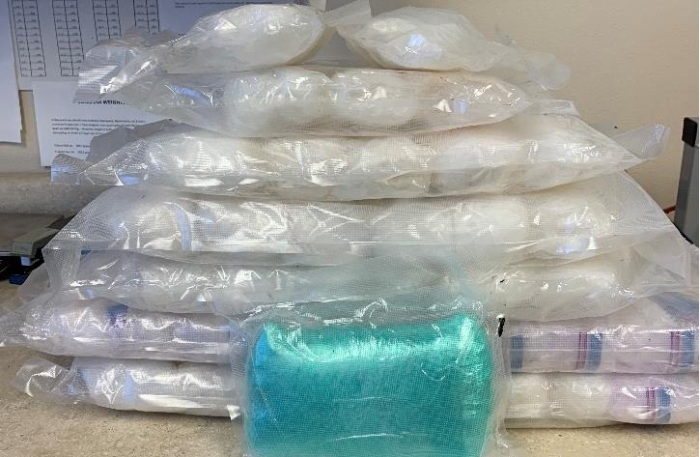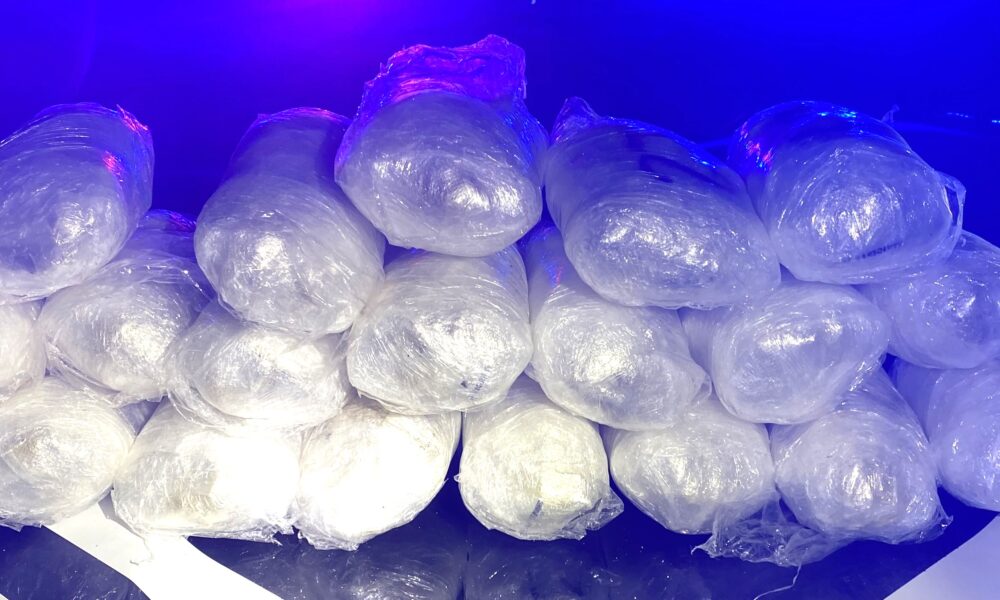Maria Medina-Zeveda needed just 45 minutes more to reach her Ontario home without incident after a long drive from southern California.
This was no ordinary road trip.
And this was no ordinary family riding in the Dodge minivan.
Secret compartments in the vehicle’s floor held 21 cellophane-wrapped packages of methamphetamine. The illegal drugs, from a deadly Mexican cartel, would be worth $63,000 on the streets in the Northwest, according to federal authorities.
Medina-Zeveda had followed U.S. 95 north from Nevada through Malheur County in Oregon and into Idaho. At about 3:30 a.m., she was about to make the turn at a highway intersection for the final push to Ontario.
Only one other vehicle was on the road in those predawn hours – an Idaho State Police trooper.
He pulled up behind the Dodge, flipping on his emergency lights to stop Medina-Zeveda. He later reported he did so because she was speeding – driving 72 in a 65-mph zone.
Whatever the true reason for the stop, the secret life Medina-Zeveda and her husband led as drug traffickers was at an end.
“These defendants were a driving force behind a significant drug trafficking organization.”
–Josh Hurwit, Idaho U.S. attorney
The traffic stop just west of Marsing, Idaho, led to federal drug convictions of Medina-Zeveda, 70, and her husband, Efren Avilez-Lopez, 81. At least four relatives in Oregon and Idaho also have been charged or convicted with drug trafficking.
According to court records and interviews, cartel-backed drug trafficking in the region has contributed to untold illegal sales, addictions, and deadly overdoses.
Ontario may not seem like an obvious hub for major drug deals, but the activity doesn’t surprise investigators.
Chris Gibson, executive director of the Oregon-Idaho High-Intensity Drug Trafficking Area program, a federal agency, said the impact of drug abuse and drug trafficking isn’t limited by geography or demographics.
“Everybody is at risk for being affected by this in one way or another and it’s a problem that has grown,” Gibson said.
Medina-Zeveda and her husband, Efren Avilez-Lopez entered the country at some point from their native Mexico, according to court records and proceedings. They made the move after their son was murdered in Mexico, living in Texas a short time before moving to Ontario in about 2005.
A decade ago, they bought a mobile home in Ontario and Avilez-Lopez worked as a crop picker and then was employed for years at Fry Foods, according to a federal prosecutor’s account during a court proceeding last year.
Officials won’t disclose when they suspected the elderly couple of being major drug traders, but a federal prosecutor last year said the husband had “significant ties” to the deadly Sinaloa drug cartel. Cartels generally control the manufacture of methamphetamine in Mexico and deploy an elaborate network to move tons illegally into the U.S. for sale. The U.S. black market drug trade is big business, generating billions each year, according to federal reports.
The elderly couple weren’t alone in their drug work. Their son and his wife and their grandson all would be caught up in the federal dragnet trying to crack organized trafficking in the Treasure Valley.
Their son, Ramon Efren Avilez-Medina, was charged with possessing methamphetamine in Idaho’s Owyhee County in 2015. He pleaded guilty three years later and is serving a 15-year sentence.
His son – the grandson of the Ontario couple – was caught in 2018 in Nampa with methamphetamine and a gun stolen in Malheur County. Efren Aviles-Pacheco, 29, who went by Alex, was charged the following year in federal court.
His attorney said in court filings that Aviles-Pacheco started using pills in high school and “gravitated towards heroin.” Because of his immigration status, he couldn’t get a driver’s license, limiting his options in the U.S.
At some point not described in detail, “His girlfriend overdosed from heroin use. She died in the same bed they were sleeping in. Her family blamed him for her death,” the attorney wrote.
Aviles-Pacheco was convicted of possessing methamphetamine in 2019, served more than two years in federal prison and then deported.
The record doesn’t establish when he illegally returned to the U.S.
But while he was in prison, his mother, Alma Pacheco, was stopped by Oregon State Police near Rome, in remote Malheur County. The stop was planned as part of a multi-agency investigation into what was later described as a “long-term drug trafficking operation.”
It was early morning in October 2020 on U.S. 95.
According to court filings, police found a secret compartment in the Chevrolet Tahoe that Pacheco was driving.
When they opened it, they pulled out 40 pounds of what was suspected to be crystal methamphetamine and a kilo of heroin wrapped in packages.
The subsequent search of Pacheco’s home found $75,000 in cash and a .380-caliber pistol.
“Pacheco confessed that she had been making trips to California to obtain narcotics for several years,” according to a court complaint.
Victor Gomez Casa, who was riding in the passenger seat with Pacheco, admitted to making runs to California with Pacheco, paying lodging costs for their trips. The Tahoe was his and he pleaded guilty last May to a federal drug charge.
Pacheco pleaded guilty to a federal drug charge in 2023 and is scheduled to be sentenced next month in U.S. District Court in Medford.
Their charges were pending when Pacheco’s son – Alex – was caught again with drugs, according to authorities. He was arrested in November 2022 for possessing methamphetamine and fentanyl. He also illegally had a gun, according to federal charges.
He has pleaded not guilty and trial is set to begin next month.
Their grandson was under a new indictment as of Feb. 15 when the older couple unwittingly sold methamphetamine to undercover officers in Nampa. According to federal authorities and court records, Avilez-Lopez and Medina-Zeveda sold five pounds of meth in a deal conducted in a store parking lot on April 15, 2023. Ten days later, the pair sold another 20 pounds of meth, again in a deal arranged in a parking lot.
Avilez-Lopez was recorded bragging how people admired him because he could conduct his drug business and stay out of law enforcement’s grasp.
About two weeks after their last Nampa deal, the couple drove to California to pick up another load of methamphetamine. It was this load that police intercepted just outside Marsing.
They ultimately pleaded guilty to federal drug charges, with the husband sentenced in February to nine years in prison. His wife was sentenced to just over three years.
“These defendants were a driving force behind a significant drug trafficking organization that, thanks to law enforcement, has been dismantled,” said Idaho U.S. Attorney Josh Hurwit said after the sentencings.
Meantime, Alma Pacheco’s brother was caught last December in Idaho with 13 pounds of methamphetamine. Federal authorities said in court filings they had tracked Victor Pacheco-Ortiz from Los Angeles before stopping him. He pleaded guilty last month.
Court records show he was tied to an earlier methamphetamine case when another trafficker was caught in Idaho with 20 pounds of methamphetamine. His cell phone revealed the address and phone number of the person who was to get the meth – Pacheco-Ortiz.
Assistant U.S. Attorney Christian Nafzger said such cases underscore the flood of illegal narcotics coming over the border from Mexico. He said fatal overdoses are up in the Treasure Valley by 40% in recent years.
He said those overdoses track with the uptick in cartel activity in more rural communities, including Indian reservations and smaller locales.
“It’s supply and demand,” he said.
The cartel’s business model is such where they come up, establish a pipeline of drugs into rural communities, according to Nafzger. He said from there, they find the people suffering from addiction and get them “hooked.”
Overdoses are hard for authorities to track but law enforcement and other county officials believe numbers in Malheur County are at an all-time high.
Highly potent and sometimes fatal drugs have flooded Malheur County. Gibson said the seizures of fentanyl pills in Malheur County jumped to 4,912 in 2023, up from 127 in 2022.
Fentanyl is mixed with other illicit drugs and is increasingly pressed into pills to look like legitimate prescription opioids.
The U.S. Drug Enforcement Agency notes that two milligrams of the drug – the amount on the tip of a pencil – is enough to kill the average person.

PREVIOUS COVERAGE
Malheur County suspects charged in drug case tied to Mexican cartels
Major drug investigation hits organized trafficking in Malheur County and Idaho
News tip? Send your information to [email protected].
HOW TO SUBSCRIBE – The Malheur Enterprise delivers quality local journalism – fair and accurate. You can read it any hour, any day with a digital subscription. Read it on your phone, your Tablet, your home computer. Click subscribe – $7.50 a month.




